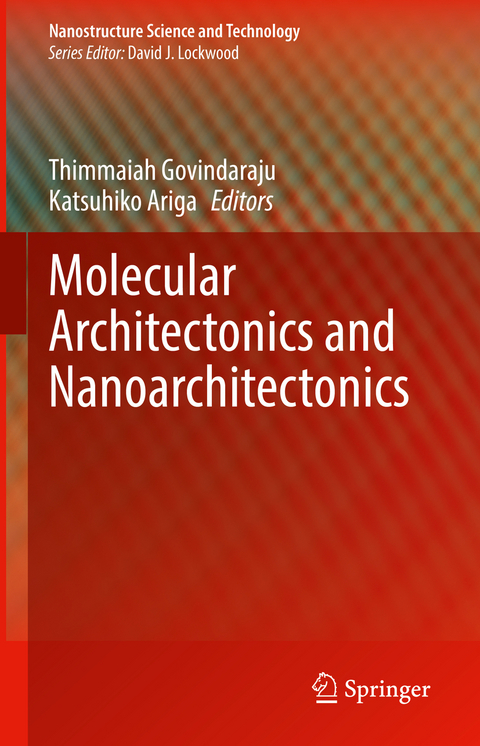
Molecular Architectonics and Nanoarchitectonics
Springer Verlag, Singapore
978-981-16-4188-6 (ISBN)
This book is the ultimate assembly of recent research activities on molecular architectonics and nanoarchitectonics by authors who are worldwide experts. The book proposes new ways of creating functional materials at the nano level using the concepts of molecular architectonics and nanoarchitectonics, which are expected to be the next-generation approaches beyond conventional nanotechnology. All the contents are categorized by types of materials, organic materials, biomaterials, and nanomaterials. For that reason, non-specialists including graduate and undergraduate students can start reading the book from any points they would like. Cutting-edge trends in nanotechnology and material sciences are easily visible in the contents of the book, which is highly useful for both students and experimental materials scientists.
Dr. Thimmaiah Govindaraju is a professor at JNCASR, Bengaluru, India. He received his M.Sc in chemistry (2000) from Bangalore University and Ph.D. (2005) from the National Chemical Laboratory and University of Pune, Pune, India. He carried out postdoctoral research at the University of Wisconsin-Madison, USA (2005–2006) and the Max Planck Institute of Molecular Physiology, Dortmund, Germany (2006–2008). His research interests are at the interface of chemistry, biology, and biomaterials science, and include molecular architectonics, nanoarchitectonics, silk-inspired biomaterials, upcycling cyclic dipeptides, diagnostic therapy and Alzheimer’s disease. He has published more than 120 papers, several book chapters, and 4 books, and holds more than 10 patents. Dr. Katsuhiko Ariga is the Leader of the Supermolecules Group and Principal Investigator of the World Premier International (WPI) Research Center for Materials Nanoarchitectonics (MANA) at the National Institute for Materials Science (NIMS). He was born in 1962, and received his Ph.D. from the Tokyo Institute of Technology (TIT) in 1990. He was appointed as a professor at The University of Tokyo in 2017. His research field is based on nanoarchitectonics, supermolecular chemistry, surface science, including the boundary research areas of organic chemistry, physical chemistry, biochemistry, and materials chemistry. He has published 700 or more scientific papers and his H-index exceeds 100.
Part 1: Molecular Architectonics and Nanoarchitectonics.- Chapter 1: Molecular architectonics.- Chapter 2: Nanoarchitectonics.- Part 2: Architectonics of functional molecules.- Chapter 3: Topological Supramolecular Polymer.- Chapter 4:Molecular architectonics guide the fabrication of self-cleaning materials.- Chapter 5: Functional discotic liquid crystals through molecular self-assembly: Towards efficient charge transport systems.- Part 3: Architectonics of peptides.- Chapter 6: Dopamine-based materials: recent advances in synthesis methods and applications.- Chapter 7: Peptide-based nanoarchitectonics: Self-assembly and biological applications.- Chapter 8: Peptide cross-b nanoarchitectures: characterizing self-Assembly mechanisms, structure and physicochemical properties.- Chapter 9: Function-inspired design of molecular hydrogels: Paradigm shifting biomaterials for biomedical applications.- Chapter 10: Smart peptide assembly architectures to mimic biology’s adaptive properties and applications.- Part 4: Architectonics of nucleic acids.- Chapter 11: Bio-inspired functional DNA architectures.- Chapter 12: Functional molecule templated DNA molecular architectonics.- Chapter 13: Architectures of nucleolipid assemblies and their applications.- Chapter 14: Nucleobase and DNA functionalized hydrogels and their applications.- Chapter 15: RNA nanoarchitectures and their applications.- Part 5: Architectonics of complex systems and advanced objects.- Chapter 16: Covalent organic frameworks as tunable supports for HER, OER and ORR catalysts- a new addition to heterogeneous electrocatalysts.- Chapter 17: Ligand functionalised nanostructures and their biomedical applications.- Chapter 18: Biomimetic composite materials and their biological applications.- Chapter 19: Combining polymers, nanomaterials, and biomolecules: Nanostructured films with functional properties and applications.- Chapter 20: Responsive polymeric architectures and their biomaterial applications.
| Erscheinungsdatum | 05.11.2021 |
|---|---|
| Reihe/Serie | Nanostructure Science and Technology |
| Zusatzinfo | 194 Illustrations, color; 48 Illustrations, black and white; IX, 548 p. 242 illus., 194 illus. in color. |
| Verlagsort | Singapore |
| Sprache | englisch |
| Maße | 155 x 235 mm |
| Themenwelt | Naturwissenschaften ► Chemie |
| Naturwissenschaften ► Physik / Astronomie ► Atom- / Kern- / Molekularphysik | |
| Naturwissenschaften ► Physik / Astronomie ► Festkörperphysik | |
| Technik ► Maschinenbau | |
| Technik ► Umwelttechnik / Biotechnologie | |
| Schlagworte | Molecular Architectonics • Nanoarchitectonics • Nanobiomaterials • Nanotechnology for Materials • Self-Assembly |
| ISBN-10 | 981-16-4188-9 / 9811641889 |
| ISBN-13 | 978-981-16-4188-6 / 9789811641886 |
| Zustand | Neuware |
| Informationen gemäß Produktsicherheitsverordnung (GPSR) | |
| Haben Sie eine Frage zum Produkt? |
aus dem Bereich


